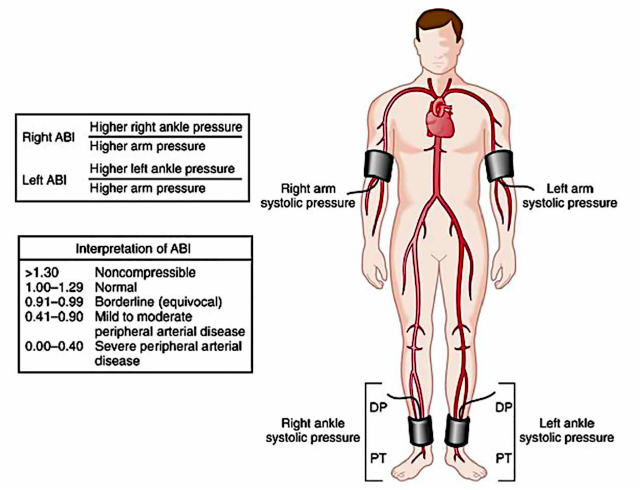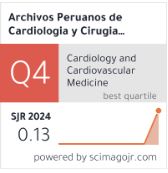Ankle-brachial index: more than a diagnostic test?
DOI:
https://doi.org/10.47487/apcyccv.v2i4.168Palabras clave:
Índice tobillo braquial, Enfermedad arterial periférica, Factores de riesgo cardiovascular, Morbilidad, MortalidadResumen
El índice tobillo-brazo (ITB) es la relación entre la presión arterial sistólica tomada entre el tobillo y la arteria braquial. Un ITB patológico (<0,90 o >1,40) indica la presencia de enfermedad arterial periférica (EAP). Muchos estudios muestran la gran utilidad de esta prueba en el diagnóstico de la EAP debido a su facilidad de uso, reproducibilidad, bajo coste y alta rentabilidad. Esta evaluación puede correlacionarse directamente con la morbilidad y mortalidad cardiovascular; sin embargo, recientemente se ha confirmado que un ITB bajo puede ser un predictor de eventos cardiovasculares mayores, ya que está relacionado con la diabetes mellitus, la enfermedad coronaria crónica y el ictus, entre otros. El objetivo de este trabajo fue revisar la evidencia actual sobre la importancia del ITB en el diagnóstico de la EAP y su papel principal como predictor de morbilidad y mortalidad cardiovascular.
Descargas
Referencias
Aday AW, Matsushita K. Epidemiology of peripheral artery disease and polyvascular disease. Circ Res. 2021;128(12):1818-32. doi: 10.1161/CIRCRESAHA.121.318535.
Eid MA, Mehta KS, Goodney PP. Epidemiology of peripheral artery disease. Semin Vasc Surg. 2021;34(1):38-46. doi: 10.1053/j.semvascsurg.2021.02.005.
Conte MS, Bradbury AW, Kolh P, White JV, Dick F, Fitridge R, et al. Global vascular guidelines on the management of chronic limbthreatening ischemia. J Vasc Surg. 2019;69(6):3S-125S.e40. doi: 10.1016/j.jvs.2019.02.016.
Matsushita K, Ballew SH, Coresh J, Arima H, Ärnlöv J, Cirillo M, et al. Measures of chronic kidney disease and risk of incident peripheral artery disease: a collaborative meta-analysis of individual participant data. Lancet Diabetes Endocrinol. 2017;5(9):718-28. doi: 10.1016/S2213-8587(17)30183-3.
Conte MS, Bradbury AW, Kolh P, White JV, Dick F, Fitridge R, et al. Global vascular guidelines on the management of chronic limb-threatening ischemia. J Vasc Surg. 2019;69(6 Suppl):3S-125S.e40.
Dieter RS, Tomasson J, Gudjonsson T, Brown RL, Vitcenda M, Einerson J, et al. Lower extremity peripheral arterial disease in hospitalized patients with coronary artery disease. Vasc Med. 2003;8(4):233-6. doi: 10.1191/1358863x03vm506ra.
Hirsch AT, Criqui MH, Treat-Jacobson D, Regensteiner JG, Creager MA, Olin JW, et al. Peripheral Arterial Disease Detection, Awareness, and Treatment in Primary Care. JAMA. 2001;286(11):1317-24. doi: 10.1001/jama.286.11.1317.
Miguel JB, Matos JPS, Lugon JR. Ankle-Brachial Index as a Predictor of Mortality in Hemodialysis: A 5-Year Cohort Study. Arq Bras Cardiol. 2017;108(3) doi: 10.5935/abc.20170026.
Ena J, Pérez-Martín S, Argente CR, Lozano T. Association between an elevated inter-arm systolic blood pressure difference, the ankle– brachial index, and mortality in patients with diabetes mellitus. Clin Investig Arterioscler. 2020;32(3):94-100. doi: 10.1016/j.arteri.2019.11.003.
Maruhashi T, Kajikawa M, Kishimoto S, Hashimoto H, Takaeko Y, Yamaji T, et al. Upstroke Time Is a Useful Vascular Marker for Detecting Patients With Coronary Artery Disease Among Subjects With Normal Ankle‐Brachial Index. J Am Heart Assoc Cardiovasc Cerebrovasc Dis. 2020;9(23):e017139. doi: 10.1161/JAHA.120.017139.
McClary KN, Massey P. Ankle Brachial Index. En: StatPearls. Treasure Island (FL): StatPearls Publishing; 2021.
Thurston B, Dawson J. Ankle Brachial Pressure Index: An update for the vascular specialist and general practitioner. Vascular. 2019;27(5):560-70. doi: 10.1177/1708538119842395.
Lowry D, Saeed M, Narendran P, Tiwari A. A review of distribution of atherosclerosis in the lower limb arteries of patients with diabetes mellitus and peripheral vascular disease. Vasc Endovascular Surg. 2018;52(7):535-42. doi: 10.1177/1538574418791622.
Myslinski W, Stanek A, Feldo M, Mosiewicz J. Ankle-Brachial Index as the Best Predictor of First Acute Coronary Syndrome in Patients with Treated Systemic Hypertension. Biomed Res Int. 2020;2020:6471098. doi: 10.1155/2020/6471098.
Lee M-Y, Hsiao P-J, Huang J-C, Hsu W-H, Chen S-C, Chang J-M, et al. Abnormally Low or High Ankle-Brachial Index Is Associated With the Development of Diabetic Retinopathy in Type 2 Diabetes Mellitus. Sci Rep. 2018;8(1):441. doi: 10.1038/s41598-017-18882-x.
Thitiwuthikiat P, Imerbtham T, Weeraphan O, Siriwittayawan D. Improvement of Cardio-Ankle Vascular Index by Arm-Swing Exercise in Older Adults. Songklanagarind Med J. 2018;36(1):53-60.
Samba H, Guerchet M, Ndamba-Bandzouzi B, Kehoua G, Mbelesso P, Desormais I, et al. Ankle Brachial Index (ABI) predicts 2-year mortality risk among older adults in the Republic of Congo: The EPIDEMCA-FU study. Atherosclerosis. 2019;286:121-7. doi: 10.1016/j.atherosclerosis.2019.05.013.
Velescu A, Clara A, Martí R, Ramos R, Perez-Fernandez S, Marcos L, et al. Abnormally High Ankle–Brachial Index is Associated with Allcause and Cardiovascular Mortality: The REGICOR Study. Eur J Vasc Endovasc Surg. 2017;54(3):370-7. doi: 10.1016/j.ejvs.2017.06.002.
Maloberti A, Cortesi P, Micale M, Mazzaglia G, Occhi L, Palazzini M, et al. Cost-effectiveness of cardiovascular risk classification based on ankle-brachial index test in association to Framingham risk score. J Hypertens. 2021;39:e274.
Perpetuini D, Chiarelli AM, Cardone D, Rinella S, Massimino S, Bianco F, et al. Photoplethysmographic Prediction of the Ankle- Brachial Pressure Index through a Machine Learning Approach. Appl Sci. 2020;10(6):2137. doi: 10.3390/app10062137.
Penagos Cordón JC, Cifuentes Escobar LM. Utilidad diagnóstica del índice tobillo-brazo por el método palpatorio en la detección de la enfermedad arterial periférica. Rev Guatem Cardiol Impresa. 2014;24(3):2-4.
Forés R, Alzamora MT, Pera G, Torán P, Urrea M, Heras A. Concordancia entre tres métodos de medición del índice tobillobrazo para el diagnóstico de arteriopatía periférica. Med Clínica. 2014;143(8):335-40.
Alzamora MT, Forés R, Baena-Díez JM, Pera G, Toran P, Sorribes M, et al. The Peripheral Arterial disease study (PERART/ARTPER): prevalence and risk factors in the general population. BMC Public Health. 2010;10(1):38. doi: 10.1186/1471-2458-10-38.
Anand SS, Caron F, Eikelboom JW, Bosch J, Dyal L, Aboyans V, et al. Major Adverse Limb Events and Mortality in Patients With Peripheral Artery Disease. J Am Coll Cardiol. 2018;71(20):2306-15. doi: 10.1016/j.jacc.2018.03.008.
Verberk WJ, Kollias A, Stergiou GS. Automated oscillometric determination of the ankle-brachial index: a systematic review and meta-analysis. Hypertens Res Off J Jpn Soc Hypertens. 2012;35(9):883-91. doi: 10.1038/hr.2012.83.
Ichihashi S, Desormais I, Hashimoto T, Magne J, Kichikawa K, Aboyans V. Accuracy and Reliability of the Ankle Brachial Index Measurement Using a Multicuff Oscillometric Device Versus the Doppler Method. Eur J Vasc Endovasc Surg. 2020;60(3):462-8. doi: 10.1016/j.ejvs.2020.06.013.
Taneva GT, Baeza Bermejillo C, Arribas Díaz AB, González García A, Fernández Bravo J, Aparicio Martínez C. Velocidades tibiales por ecografía Doppler y validez del índice tobillo-profunda en la enfermedad arterial periférica. Angiología. 2018;70(4):163-8.
Diehm N, Shang A, Silvestro A, Do D-D, Dick F, Schmidli J, et al. Association of cardiovascular risk factors with pattern of lower limb atherosclerosis in 2659 patients undergoing angioplasty. Eur J Vasc Endovasc Surg. 2006;31(1):59-63. doi: 10.1016/j.ejvs.2005.09.006
Kodikara KG, Karunaratne WCD, Chandratilake MN. High fidelity simulation in undergraduate medical curricula: experience of fourth year medical students. South-East Asian J Med Educ. 2020;13(2):25-31.
Meijer WT, Hoes AW, Rutgers D, Bots ML, Hofman A, Grobbee DE. Peripheral arterial disease in the elderly: The Rotterdam Study. Arterioscler Thromb Vasc Biol. 1998;18(2):185-92.
Takahashi T, Tomiyama H, Aboyans V, Kumai K, Nakano H, Fujii M, et al. Association of pulse wave velocity and pressure wave reflection with the ankle-brachial pressure index in Japanese men not suffering from peripheral artery disease. Atherosclerosis. 2021;317:29-35. doi: 10.1016/j.atherosclerosis.2020.11.031.
Coyan GN, D’Angelo MP, Kilic A, Gleason TG, Luketich JD, Aranda-Michel E, et al. Evaluation of a simulation-based mini-elective on medical student interest in cardiac surgery. J Card Surg. 2019;34(10):901-7. doi: 10.1111/jocs.14143.
Criqui MH, Matsushita K, Aboyans V, Hess CN, Hicks CW, Kwan TW, et al. Lower Extremity Peripheral Artery Disease: Contemporary Epidemiology, Management Gaps, and Future Directions: A Scientific Statement From the American Heart Association. Circulation. 2021;144(9):e171-e191. doi: 10.1161/CIR.0000000000001005.
Venermo M, Sprynger M, Desormais I, Björck M, Brodmann M, Cohnert T, et al. Editor’s Choice – Follow-up of Patients After Revascularisation for Peripheral Arterial Diseases: A Consensus Document From the European Society of Cardiology Working Group on Aorta and Peripheral Vascular Diseases and the European Society for Vascular Surgery. Eur J Vasc Endovasc Surg. 2019;58(5):641-53. doi: 10.1016/j.ejvs.2019.06.017.
Recarey Pittí L del C, Mosquera Fernández A, Bellido Guerrero D. Grado de evidencia en la utilización del índice tobillo-brazo para el diagnóstico de la Arteriopatía Periférica en diabéticos tipo 2. Rev Int Cienc Podol. 2015;9(1):37-43. doi: 10.5209/rev_RICP.2015.v9.n1.47315.
Hageman D, van den Houten MML, Pesser N, Gommans LNM, Scheltinga MRM, Teijink JAW. Diagnostic accuracy of automated oscillometric determination of the ankle-brachial index in peripheral artery disease. J Vasc Surg. 2021;73(2):652-60. doi: 10.1016/j.jvs.2020.05.077.
Ruiz Comellas A, Pera G, Baena Díez JM, Heras A, Alzamora Sas MT, Forés Raurell R, et al. Relación entre actividad física en el tiempo libre y el índice tobillo-brazo en población general española: estudio ARTPER. Med Clínica. 2015;145(10):419-26.
Hiatt WR, Hess CN, Bonaca MP, Kavanagh S, Patel MR, Baumgartner I, et al. Ankle-Brachial Index for Risk Stratification in Patients With Symptomatic Peripheral Artery Disease With and Without Prior Lower Extremity Revascularization: Observations From the EUCLID Trial. Circ Cardiovasc Interv. 2021;14(7):e009871. doi: 10.1161/CIRCINTERVENTIONS.120.009871.
Diehm N, Shang A, Silvestro A, Do D-D, Dick F, Schmidli J, et al. Association of cardiovascular risk factors with pattern of lower limb atherosclerosis in 2659 patients undergoing angioplasty. Eur J Vasc Endovasc Surg. 2006;31(1):59-63. doi: 10.1016/j.ejvs.2005.09.006.
Kärberg K, Lember M. Subclinical atherosclerosis in the carotid artery: can the ankle-brachial index predict it in type 2 diabetes patients? Scand J Clin Lab Invest. 2021;81(3):237-43. doi: 10.1080/00365513.2021.1904279.
Oliveras V, Martín-Baranera M, Gracia M, del Val JL, Plans M, Pujol-Moix N. Importancia del índice tobillo-brazo en la reclasificación del riesgo cardiovascular de varones hipertensos asintomáticos de mediana edad. Med Clínica. 2015;144(10):435-9.
Ramos MV, Ramos MV. Aspectos destacados de las Guías de la Sociedad Europea de Cardiología sobre cardiología deportiva y ejercicio en pacientes con enfermedad cardiovascular. Rev Urug Cardiol. 2020;35(3):61-86.
Abdelmonaem M, Reda A, Nour A. Correlation Between Ankle Brachial Index and SYNTAX Score to Predict Severity of Coronary Artery Disease [Internet]. Vascular Disease Management. 2021 [citado 12 de septiembre de 2021]. Disponible en: https://www.hmpgloballearningnetwork.com/site/vdm/content/correlationbetween-ankle-brachial-index-and-syntax-score-predict-severitycoronary-artery
Sharma AK, Kejriwal MP, Sinha SK, Razi M M, Pandey U, Shukla P, Thakur R, Verma C M, Krishna V. A comparative assessment of the severity of coronary artery disease in patients with low ankle–Brachial index and normal ankle–Brachial index: An angiographybased cross-sectional observational-analytical study (CADLABI study). J Pract Cardiovasc Sci 2021;7:54-9.
Núñez D, Morillas P, Quiles J, Cordero A, Guindo J, Soria F, et al. Utilidad de un índice tobillo-brazo patológico en la identificación de la enfermedad coronaria multivaso en pacientes con síndrome coronario agudo. Rev Esp Cardiol. 2010;63(1):54-9.
Pichín Quesada A, Goulet Ordaz L, Suárez Lescay C, Franco Mora M del C. Pacientes con cardiopatía isquémica y enfermedad arterial periférica asintomática determinada mediante el índice tobillo-brazo. MEDISAN. 2017;21(1):1-11.
Strandness D, Priest R, Gibbons G. Combined clinical and pathologic study of diabetic and nondiabetic peripheral arterial disease. Diabetes. 1964;13(4):366-72.
Garduño LMM, Rocha RB, Pérez FJG, Salinas CAA. Relación del índice tobillo/brazo determinado por ultrasonido Doppler con desenlaces cardiovasculares y amputación en un grupo de pacientes con diabetes mellitus 2 estudiados en el Instituto Nacional de Ciencias Médicas y Nutrición Salvador Zubirán. Gac Med Mex. 2011;147(2):111-6.
Domínguez GV, Cabrera HM. Evaluación de la concordancia entre los valores del índice tobillo-brazo y presiones segmentarias con amputacion del pie diabético. Rev Soc Peru Med Interna. 2013;26(4):184-92.
Baghdasaryan PA, Bae JH, Yu W, Rowe V, Armstrong DG, Shavelle DM, et al. “The Renal Foot”-Angiographic Pattern of Patients with Chronic Limb Threatening Ischemia and End-Stage Renal Disease. Cardiovasc Revasc Med. 2020;21(1):118-21. doi: 10.1016/j.carrev.2019.09.001.
Garimella PS, Hirsch AT. Peripheral Artery Disease and Chronic Kidney Disease: Clinical Synergy to Improve Outcomes. Adv Chronic Kidney Dis. 2014;21(6):460-71. doi: 10.1053/j.ackd.2014.07.005.
Chen H-Y, Wei F, Wang L-H, Wang Z, Meng J, Yu H-B, et al. Abnormal ankle-brachial index and risk of cardiovascular or all-cause mortality in patients with chronic kidney disease: a meta-analysis. J Nephrol. 2017;30(4):493-501. doi: 10.1007/s40620-017-0376-z.
Ratnatunga P, Gunawardene R, Pinto V, Perera R, Amerasinghe P, Hewavithana P, et al. Atherosclerotic occlusive arterial disease of the lower limbs: a historical account of surgical evolution and vascular reconstruction over thirty four years. Sri Lanka J Surg. 2018;36(2):1-7. doi: 10.4038/sljs.v36i2.8508.
Fuglestad MA, Hernandez H, Gao Y, Ybay H, Schieber MN, Brunette KE, et al. A low-cost, wireless near-infrared spectroscopy device detects the presence of lower extremity atherosclerosis as measured by computed tomographic angiography and characterizes walking impairment in peripheral artery disease. J Vasc Surg. 2020;71(3):946-57. doi: 10.1016/j.jvs.2019.04.493.
Oriol Torón PÁ, Badía Farré T, Romaguera Lliso A, Roda Diestro J. Síndrome metabólico y enfermedad arterial periférica: 2 enfermedades relacionadas. Endocrinol Nutr. 2016;63(6):258-64.
Estirado E, Lahoz C, Laguna F, García-Iglesias F, González-Alegre MT, Mostaza JM. Síndrome metabólico en pacientes con enfermedad arterial periférica. Rev Clínica Esp. 2014;214(8):437-44.
Hong JB, Leonards CO, Endres M, Siegerink B, Liman TG. Ankle-Brachial Index and Recurrent Stroke Risk: Meta-Analysis. Stroke. 2016;47(2):317-22. doi: 10.1161/STROKEAHA.115.011321.
Sander D, Poppert H, Sander K, Etgen T. The role of intima-mediathickness, ankle-brachial-index and inflammatory biochemical parameters for stroke risk prediction: a systematic review. Eur J Neurol. 2012;19(4):544-e36. doi: 10.1111/j.1468-1331.2011.03510.x.
Fan H, Hu X, Yu W, Cao H, Wang J, Li J, et al. Low ankle-brachial index and risk of stroke. Atherosclerosis. 2013;229(2):317-23. doi: 10.1016/j.atherosclerosis.2013.05.014.


















